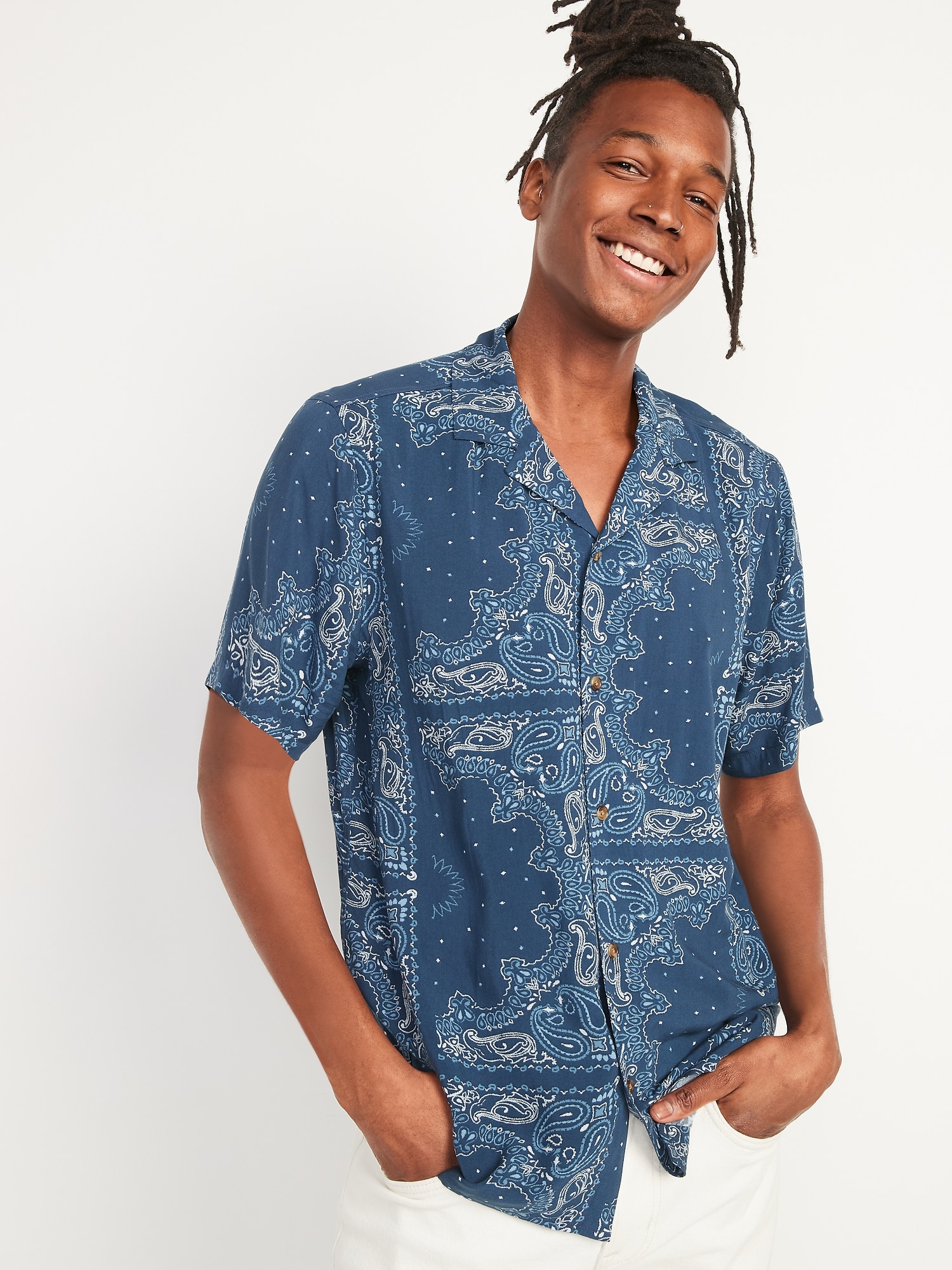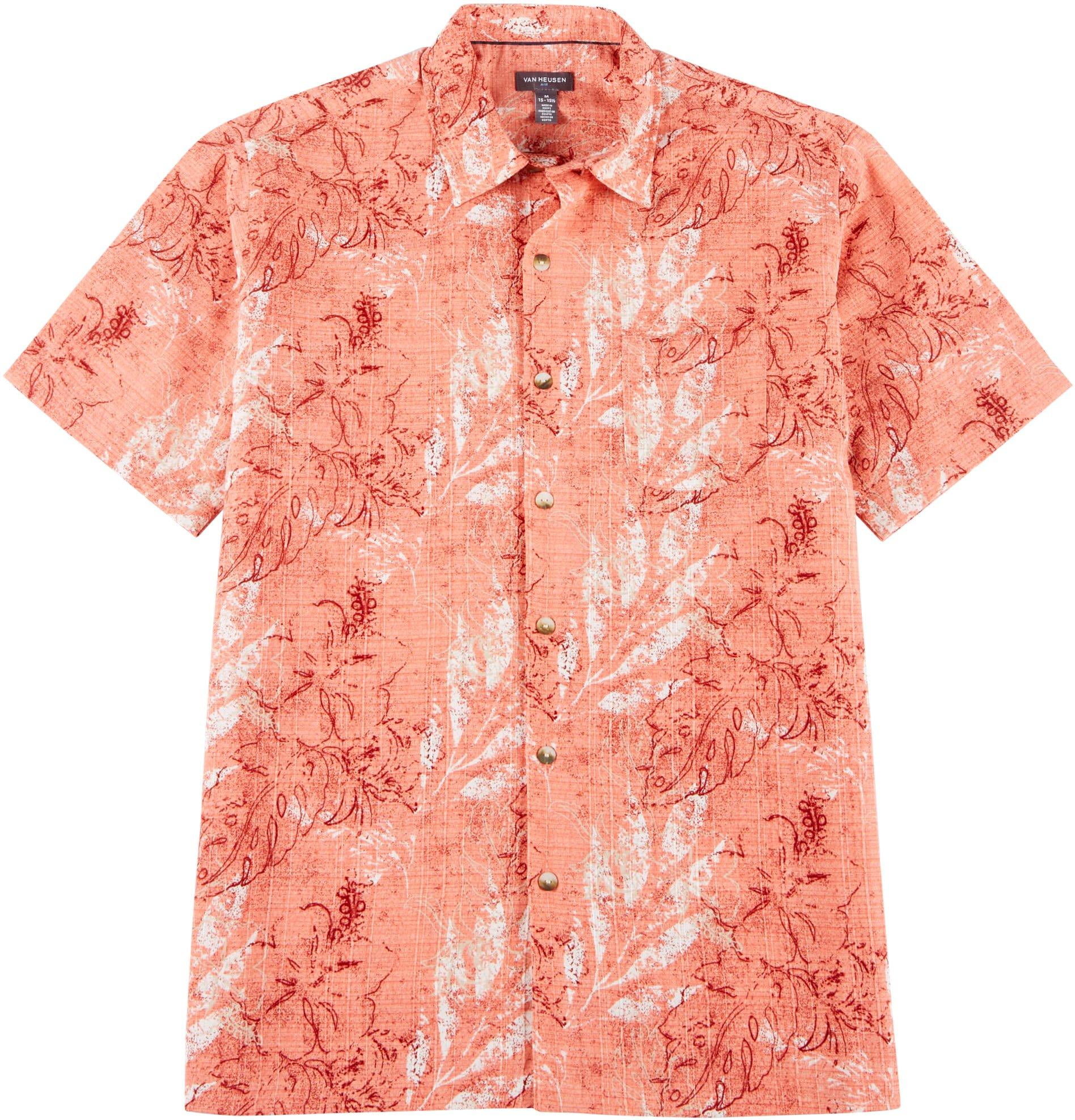What are camp shirts?
Camp shirts, also known as camp collar shirts or bowling shirts, are casual button-up shirts that are often associated with a relaxed and tropical style. They are characterized by their open and wide collar, which lays flat instead of standing up like traditional dress shirts. Camp shirts typically have a loose and relaxed fit, with straight hems and short sleeves.
These shirts are commonly made from lightweight and breathable fabrics such as cotton, linen, or rayon, which make them comfortable to wear in warm weather. The loose fit and breathable materials allow for better airflow, helping to keep the body cool and comfortable.
Camp shirts are known for their versatility and can be found in various designs and patterns, including solid colors, floral prints, Hawaiian motifs, or retro-inspired designs. They offer a casual and laid-back aesthetic, making them suitable for both casual and semi-formal occasions, depending on the specific design and styling.
These shirts gained popularity in the mid-20th century and were often worn by vacationers, resort-goers, and individuals seeking a relaxed and leisurely style. Today, camp shirts continue to be a popular choice for those who want to embrace a casual and tropical vibe, whether it’s for a beach vacation, a summer outing, or simply to add a touch of retro-cool to their wardrobe.

History and evolution of camp shirts
The origins of camp shirts can be traced back to the 1920s and 1930s in Hawaii. It is believed that they were inspired by the colorful and vibrant garments worn by Japanese immigrants who worked on Hawaii’s pineapple and sugar cane plantations. These immigrants brought with them the tradition of wearing loose-fitting, comfortable, and brightly patterned clothing.
In the 1930s, the first commercially produced camp shirts emerged. Local businesses in Hawaii started manufacturing and selling these shirts, catering to both locals and tourists who were drawn to their unique and relaxed style. The shirts featured bold and eye-catching prints, often depicting nature, tropical motifs, or indigenous Hawaiian designs.
During the 1940s and 1950s, World War II soldiers stationed in Hawaii discovered the camp shirts and brought them back to the United States as souvenirs. This led to their growing popularity and exposure outside of Hawaii. The shirts became associated with a carefree and tropical lifestyle, and wearing them became a symbol of leisure, vacation, and relaxation.
In the 1960s, the camp shirt gained even more popularity with the rise of the Tiki culture and the popularity of Hawaiian-themed parties and events. Celebrities like Elvis Presley and Frank Sinatra were often seen wearing camp shirts, further cementing their status as a stylish and trendy garment.
In recent years, camp shirts have seen a resurgence in popularity, becoming a staple in both men’s and women’s fashion. Contemporary designs feature a mix of traditional Hawaiian prints, modern interpretations, and collaborations with renowned designers. The shirts have also become more versatile, with slimmer cuts and variations that can be dressed up or down for different occasions.
Features of Men’s Camp Shirts

A. Fabric selection for durability and comfort
When it comes to men’s camp shirts, fabric selection is crucial for both durability and comfort. Look for shirts made from sturdy materials like cotton or linen, which can withstand the rigors of outdoor activities. These fabrics are also breathable, allowing for proper airflow and temperature regulation.
B. Fit options: Regular, slim, and relaxed
Men’s camp shirts come in various fit options to suit different preferences and body types. Regular fit shirts offer a classic and comfortable silhouette, while slim fit shirts provide a more tailored and modern look. Relaxed fit shirts offer a looser and more casual style, perfect for those seeking extra comfort and freedom of movement.
C. Collar styles and shirt variations

Camp shirts for men often feature different collar styles and variations. The traditional camp collar is a flat, pointed collar that lays flat and creates a relaxed look. Other variations may include button-down collars or convertible collars that can be worn open or closed. Additionally, men’s camp shirts may come with short sleeves, long sleeves, or even sleeveless options, catering to different preferences and weather conditions.
Styling Tips for Men’s Camp Shirts
A. Casual outdoor looks
-
Pairing camp shirts with shorts
For a casual outdoor look, pair your camp shirt with a comfortable pair of shorts. Opt for shorts in neutral colors or prints that complement the color and pattern of the shirt. Choose lightweight and breathable fabrics like cotton or linen for both the shirt and shorts to keep you cool and comfortable.
-
Choosing appropriate footwear
Complete your casual outdoor look by selecting appropriate footwear. For a laid-back vibe, opt for sandals or canvas sneakers. If you’ll be doing more strenuous activities, consider athletic shoes or hiking sandals for added support and grip. Choose footwear that matches the level of comfort and functionality you require for your outdoor adventures.
B. Dressier camp shirt outfits
-
Camp shirts for beach weddings
Camp shirts can be a stylish choice for beach weddings. Pair a camp shirt with lightweight trousers in a complementary color. Opt for trousers in linen or a blend of linen and cotton for a breezy and elegant look. Complete the outfit with leather loafers or boat shoes for a refined yet relaxed beach wedding look.

-
Dressing up camp shirts for evening events
To dress up a camp shirt for evening events, pair it with tailored trousers or chinos in a darker shade. Tuck in the camp shirt for a more polished appearance. Consider layering with a lightweight blazer or a cardigan for added sophistication. Complete the outfit with leather dress shoes or loafers to elevate the overall look.
Care and Maintenance of Men’s Camp Shirts
A. Washing and drying instructions
To properly care for men’s camp shirts, follow these washing and drying instructions:
- Check the care label for specific instructions regarding water temperature and washing method.
- Machine wash the shirts on a gentle cycle using a mild detergent.
- Avoid using bleach or harsh chemicals that may damage the fabric.
- If necessary, treat stains with a stain remover before washing.
- After washing, hang the shirts to air dry or tumble dry on low heat to prevent shrinkage.
B. Ironing and storage tips

Keep men’s camp shirts looking crisp and wrinkle-free with these ironing and storage tips:
- Iron the shirts on the appropriate setting for the fabric, following the label instructions.
- Start with a lower heat setting and gradually increase as needed to avoid scorching the fabric.
- Use a pressing cloth or a clean cotton cloth when ironing delicate fabrics or prints.
- Store the shirts in a cool, dry place to prevent wrinkles and maintain their shape.
- If hanging the shirts, use hangers that are wide and padded to avoid stretching the shoulders.
C. Repairing minor damages
Address minor damages promptly to prolong the lifespan of men’s camp shirts:
- Fix loose buttons by sewing them back on securely.
- Mend small tears or loose seams with a needle and thread.
- Use iron-on patches or fabric glue to repair small holes or tears.
- Remove loose threads with small scissors to prevent further unraveling.
- For more extensive repairs, consult a professional tailor or seamstress.
In conclusion, proper care and maintenance of men’s camp shirts involve following washing and drying instructions, ironing with care, and storing them correctly. Additionally, addressing minor damages promptly can extend the lifespan of the shirts. By implementing these care tips, you can keep your men’s camp shirts looking fresh and in good condition for many outdoor adventures to come.



















+ There are no comments
Add yours